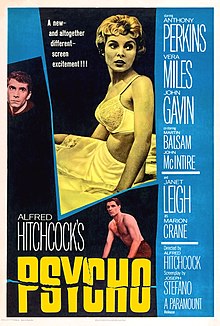
Back Psycho (cinta de 1960) AN سايكو (فيلم) Arabic سايكو (فيلم 1960) ARZ Psixo (film, 1960) AZ Псіха (фільм, 1960) BE Психо (филм, 1960) Bulgarian সাইকো (১৯৬০-এর চলচ্চিত্র) Bengali/Bangla Psiho (1960) BS Psicosi (pel·lícula de 1960) Catalan Psycho (pelikula nga 1960) CEB
| Psycho | |
|---|---|
 | |
| Directed by | Alfred Hitchcock |
| Screenplay by | Joseph Stefano |
| Based on | Psycho by Robert Bloch |
| Produced by | Alfred Hitchcock |
| Starring | |
| Cinematography | John L. Russell |
| Edited by | George Tomasini |
| Music by | Bernard Herrmann |
Production company | Shamley Productions |
| Distributed by | Paramount Pictures[a] |
Release dates | |
Running time | 109 minutes |
| Country | United States[5] |
| Language | English |
| Budget | $806,947[6] |
| Box office | $50 million[7] |
Psycho is a 1960 American horror film produced and directed by Alfred Hitchcock. The screenplay, written by Joseph Stefano, was based on the 1959 novel of the same name by Robert Bloch. The film stars Anthony Perkins, Janet Leigh, Vera Miles, John Gavin and Martin Balsam. The plot centers on an encounter between on-the-run embezzler Marion Crane (Leigh) and shy motel proprietor Norman Bates (Perkins) and its aftermath, in which a private investigator (Balsam), Marion's lover Sam Loomis (Gavin) and her sister Lila (Miles) investigate her disappearance.[8]
Psycho was seen as a departure from Hitchcock's previous film, North by Northwest (1959), as it was filmed on a small budget in black-and-white by the crew of his television series Alfred Hitchcock Presents. Initially, the film divided critics due to its controversial subject matter, but audience interest and outstanding box-office returns prompted a major critical re-evaluation. Psycho was nominated for four Academy Awards, including Best Director for Hitchcock and Best Supporting Actress for Leigh.
Psycho is now considered one of Hitchcock's best films,[b] and is arguably his most famous and influential work.[9] It has been hailed as a major work of cinematic art by international film critics and scholars who praise its slick direction, tense atmosphere, impressive camerawork, memorable score and iconic performances. It is regarded as "the most heavily analyzed film in the long career of the most investigated director in the history of American film"[10] and often ranked among the greatest films of all time. It set a new level of acceptability for violence, deviant behavior and sexuality in American films,[11] and has been considered to be one of the earliest examples of the slasher film genre. After Hitchcock's death in 1980, Universal Pictures produced follow-ups: three sequels, a remake, a made-for-television spin-off and a television series. In 1992, the Library of Congress deemed the film "culturally, historically, or aesthetically significant" and selected it for preservation in the United States National Film Registry.[12][13]
- ^ "Muere Mac, el mítico cartelista de 'Doctor Zhivago' y 'Psicosis'". El Periódico de Catalunya (in Spanish). July 21, 2018. Archived from the original on July 27, 2018. Retrieved August 18, 2018.
- ^ "Psycho (1960): Notes". tcm.com. Turner Classic Movies. Retrieved April 25, 2017.
- ^ Cite error: The named reference
AFIwas invoked but never defined (see the help page). - ^ Hedrick, Lizzie (September 8, 2015). "8 Reasons Psycho Taps into the Psyche". USC Dornsife. Archived from the original on June 18, 2020. Retrieved June 17, 2020.
- ^ "Psycho (1960)". British Film Institute. Archived from the original on January 16, 2015. Retrieved December 30, 2014.
- ^ "Psycho (1960)". Box Office Mojo. Retrieved October 20, 2014.
- ^ Nixon, Rob. "The Critics' Corner: PSYCHO". Turner Classic Movies. Archived from the original on December 30, 2014. Retrieved December 30, 2014.
- ^ "Psycho (1960) – Full Synopsis". Turner Classic Movies. Archived from the original on June 16, 2018. Retrieved June 16, 2018.
- ^ "Psycho turns 60 – Hitchcock's famous fright film broke all the rules". The Conversation. June 15, 2020. Archived from the original on December 17, 2020. Retrieved January 22, 2021.
- ^ Phillips, Kendall R. (2005). Projected fears: horror films and American culture (1. publ ed.). Westport, Conn.: Praeger. p. 61. ISBN 978-0-275-98353-6.
- ^ "Psycho reviews". Rotten Tomatoes. Archived from the original on March 23, 2010. Retrieved April 17, 2010.
- ^ "Complete National Film Registry Listing". Library of Congress. Archived from the original on October 31, 2016. Retrieved May 8, 2020.
- ^ Marx, Andy; Wharton, Dennis (December 4, 1992). "Diverse pix mix picked". Variety. Archived from the original on August 4, 2020. Retrieved August 4, 2020.
Cite error: There are <ref group=lower-alpha> tags or {{efn}} templates on this page, but the references will not show without a {{reflist|group=lower-alpha}} template or {{notelist}} template (see the help page).